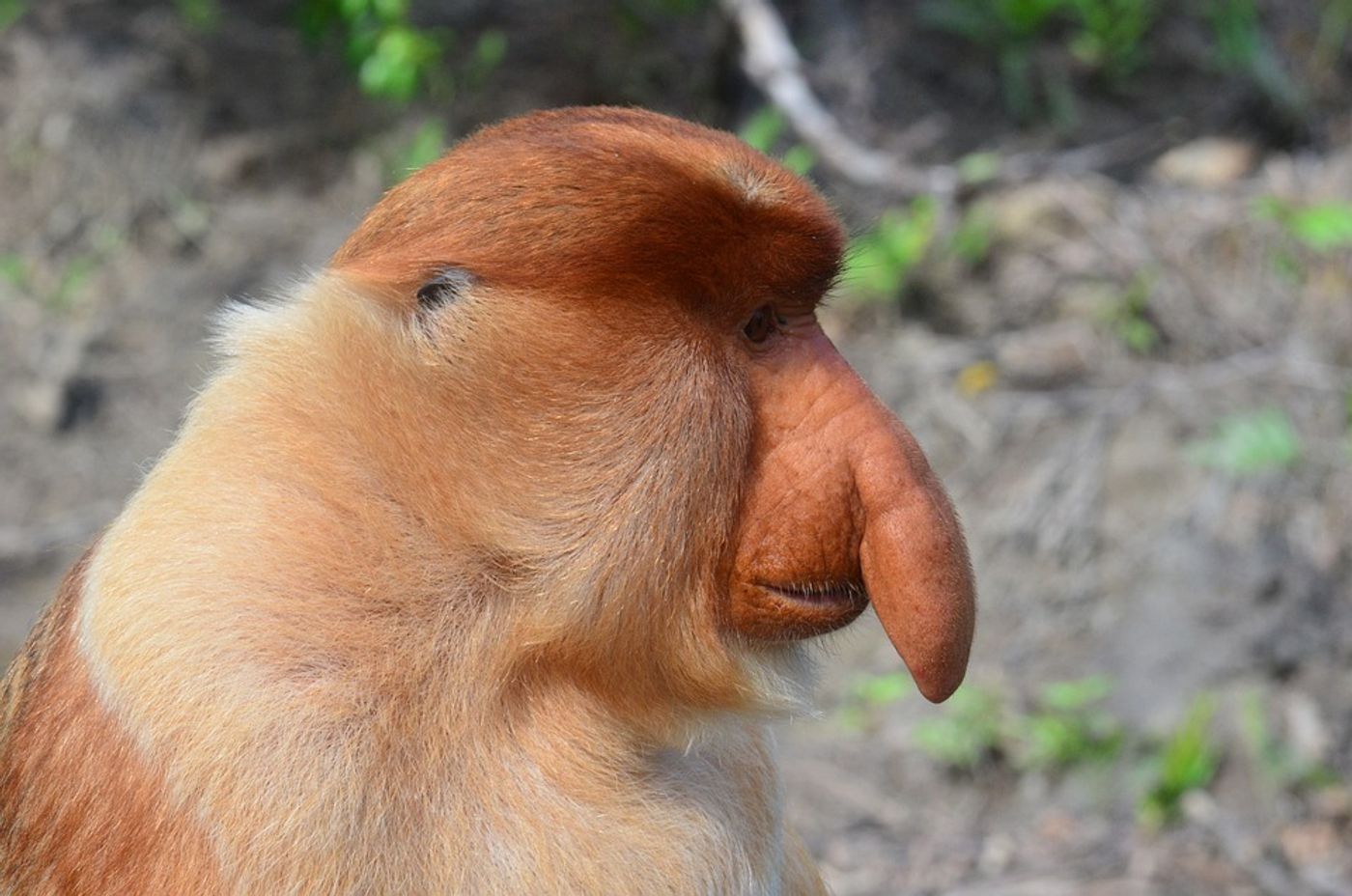In honor of Halloween, here are the six weirdest monkeys in the world
Humans are often considered a weird primate—we’re hairless, walk exclusively on two legs, wear clothes, cook our food, and the list goes on. However, we certainly aren’t the only weird primates out there, and it could be argued that some monkeys are even weirder and wilder than humans, from venomous bites to bright red, hairless faces to full-moon fights, meet six of the weirdest monkeys:
1. Aye-aye (Daubentonia madagascariensis)
The aye-aye, a species of lemur living in Madagascar, is the largest nocturnal primate. Physically, they have large, gremlin-like eyes; a long, shaggy coat of dark hair with white-tips; a pale face; and large, black ears. They have a big, bushy tail most similar to a squirrels and slightly odd teeth including a massive pair of incisors (the two front teeth) which grow continuously. All of that combined is enough to classify the aye-aye as a weird monkey, but their strangest trait may be their “wiry third digit,” in other words, the very long, very thin third finger on each hand.
This finger is used for hunting at night, where the aye-aye moves along a branch tapping the wood while listening intently with its huge, bat-like ears. If they hear a hollow sound, followed by the rustling of insect lava moving deep within the tree, they will use those incisors to start gnawing on the wood until they can use their wiry finger to pierce the larva. As you can imagine, this could be a dangerous task where pieces of wood are flying everywhere, but the aye-aye has another adaptation to help with this: a third eyelid to protect their eyes from the debris.
Aye-ayes tend to be relatively solitary, sleeping alone in nests made of twigs. They will usually hang upside down from a tree to groom, using that wiry finger to clean their ears, eyes, and nose. Unfortunately, due to some of their stranger behavior and weirder anatomy, the aye-ayes had been considered a death omen by Malagasy people. For this reason—combined with their taste for coconuts which angers farmers—aye-ayes were hunted to supposed extinction in 1935. Luckily, the population was rediscovered in 1957 and conservation efforts are keeping this weird primate’s population stable.
2. Bald uakari (Cacajao calvus)
The bald uakari (pronounced “wakari”) is a monkey living in Brazil and Peru, throughout the Amazon rainforest. Their appearance is particularly unique—and arguably quite frightening—with smaller, bald, bright red faces underneath shaggy orange or white fur.
Uakaris tend to live at the tops of trees, likely because their home in the Amazon river basin is flooded for several months a year. Therefore, they are most commonly heard before they’re seen, with observers hearing crashing branches while the monkeys leap between tree crowns. In some cases, uakaris will rock branches back and forth to build momentum before leaping. If and when they are disturbed, they will flick their (relatively short) tail repeatedly, sometimes uttering a high-pitched scream.
In addition to their strange faces, their teeth are also slightly odd. To take advantage of lack of food competition, uakaris mostly eat unripe foods with their specialized canines and particularly strong jaw muscles which allow them to break into the tough outer shell of fruit. Then, they’ll use their specialized incisors to scrape out the tougher flesh. When fruit is low, they’ll use these same anatomical adaptations to crack open seeds. Unlike other primates, they lack an opposable thumb and therefore they have to hold food between their index and middle finger. Due to their remote location—which is inaccessible to humans during flood season—they are relatively understudied leaving much more to learn about this strange looking primate. If you’re tasked with writing essays on unique topics like the bald uakari, Papersowl can provide professional assistance to ensure your work stands out.
3. Greater slow loris (Nycticebus coucang)
The greater slow loris—native to Sumatra, Malaysia, and Thailand—were given their name due to the slow, careful way in which they move across branches to hunt their prey. If they are feeling threatened, they will freeze and hang upside down, helped by an anatomical adaptation called the retia mirabilia, or “wonderful net.” The retia mirabilia are an arterial net that allows blood to flow freely and exchange oxygen without movement, thus allowing animals to stay frozen for long periods of time.
Slow lorises are mysterious creatures—in part due to their nocturnal nature which makes studying them deep in the forest at night relatively difficult—known as “cryptic species,” or animals that look so similar that only DNA can tell them apart. Another component of their mysterious nature is their coloration. They have an almost googly-eyed appearance with big, circular eyes surrounded by black fur, which scientists think could be to reduce the dazzle from light reflection which allows them to avoid being seen by other animals. They tend to have a reduced second finger, and an opposable big toe, which likely helps them climb around on branches.
Like other nocturnal animals, they are relatively understudied. But, there are a few behaviors which are known—like infant parking, which happens when lorises leave their infants in a hollowed-out tree while they go forage for food. But, the component that classifies them as one of the weirdest primates is their predator avoidance tactic. Slow lorises lick the inside of their arms, which happens to hold glands that secrete a sweat-like toxic substance. Saliva activates these toxins making a bite from a slow loris actually quite dangerous. Their long, razor-sharp canine teeth can inflict pretty deep lacerations which—when combined with their toxic secretions—can send humans into anaphylactic shock, or even cause death.
4. Patas monkey (Erythrocebus patas)
Patas monkeys may be the most typical looking monkey on this list, but when it comes to their behavior they are anything but. They are known as cursorial monkeys—meaning their relatively slim bodies with long, graceful limbs are adapted for running. Patas monkeys are the fastest primate and they have the ability to run up to 35 miles per hour. They are committed to a terrestrial lifestyle, and don’t venture up into the trees like other monkeys. Patas monkeys live throughout Africa in the northern tropical rainforest belt in large groups of up to 70 individuals, usually all females with just one male. That one male spends most of his time watching for predators, while females groom each other and help care for each other’s infants. When a male reaches puberty, he’ll often leave his natal group (sometimes taking along a brother) and look for another group to join. If the group he wants to join already has a male, he will work to overthrow him.
The predation strategy of patas monkeys is one of stealth—they are very quiet and do not make much noise. To keep track of each other, they will stand on two legs and scan the area. At sunset each night, every monkey climbs into their own tree to sleep.
Their cursorial nature, combined with their group size, allows patas monkeys to have a relatively large home range of up to 15 square miles, with monkeys traveling up to six miles per day in search of food. Their diet is variable, and often includes crops making them unpopular with farmers. For this reason—and their role in traditional medicine—they are often hunted. Their bones are thought to cure snake bites and their skulls are thought to aid in accident prevention, though the population remains relatively stable despite this. Another reason for their relatively stable population could be thanks to Dr. Seuss—rumor has it that the Lorax is modeled after the patas monkey.
5. Proboscis monkey (Nasalis larvatus)
On the island of Borneo, in mangroves and palm swamps, you’ll find the Proboscis monkeys. Locals call them Dutchmen due to their pink faces, pot belly, ambling gait, and the male’s massive nose (an unflattering, but perhaps earned, reference to their former colonial rulers). Females do not have the massive, pendulous nose that characterizes the species, but they have their own unique, small, upturned nose. The different shape of their noses means the calls of males and females are quite different—the call tends to be a loud honk for males, while the female call sounds more like a goose. Both male and female bodies are mostly orange, with whitish-gray fur on the belly and tail. Infants are born with a blue face and dark fur; their fur lightens around eight months and their face turns pink around age three.
Due to their habitat, they must often cross rivers and inlets to reach trees on another bank. They’ll do this by catapulting over the water, and subsequently crashing into the trees on the other side. If—as often happens—they fail, they will dive and belly flop into the water below. In the water, they are relatively adept swimmers thanks to their partially webbed hands and feet. They’re able to swim for up to 20 meters, and usually swim quickly, in a single file in groups to avoid being crocodile prey. For food, they mostly eat mature leaves which they are able to digest thanks to their chambered stomachs but when available they eat fruit, too.
The male’s nose is what gives them a place on this list, and also what is to credit for the booming tourist industry in Borneo. They now rival orangutans as the most-visited primate in Borneo and are often seen—or more likely heard—clambering through the trees.
6. Red-necked owl monkey (Aotus nigriceps)
Owl monkeys—or night monkeys as they are also called—are the only monkey who is truly adapted to nighttime foraging. They get their name from the similarity of their loud vocalizations to those of owls. While this list has discussed other monkeys who are nocturnal, the unique thing about owl monkeys is that they specifically evolved nocturnal features—they evolved from a diurnal (i.e., active during the day) ancestor potentially to avoid predation and competition with other primates. Unlike other nocturnal primates, they are missing the tapetum lucidem, or the specialized eye membrane which reflects light rays back through the retina. Instead, they have very big, globular eyes which allow them to see as much light as possible, though the trade-off is that they cannot see in color. They can be awake during the day, unlike truly nocturnal animals, and on a particularly cold and dark night, tend to be active during the day—defining them as a cathemeral species.
In addition, they’re the only truly monogamous monkey, participating in something called “serial monogamy” where they are with one partner at a time, though there is frequent turnover among who that partner is. New pairs are typically formed following a period of aggression. When an infant is born, the mother will carry it for the first week and then the father takes over completely. The father will bring the infant to the mother to feed, but otherwise takes complete care of the infant—a particularly rare behavior among primates.
On bright nights, owl monkeys tend to travel twice as far guided by moonlight. They are extremely territorial, and if they encounter another group a severe fight will break out. The frosted appearance of their fur makes them easier to see in a full moon.
Sources: Primates of the World, The Primate Family Tree, Smithsonian Magazine











